.jpg)
Volkswagen Transporter Van Review
.jpg)
Introduction
Careful updates have kept the Volkswagen Transporter fresh, with this updated version able to trace its roots right back to 2003. Don’t think this is anything but a thoroughly modern van though, as there’s a fine blend of economical and powerful engines, four-wheel drive is available, and there’s interior trim from strictly functional to positively plush.
Add in a range of models from airport-taxi-friendly Shuttle models to the glamping made easy California, as well as a chassis cab, and crew-cab Kombi models, and there’s a model for virtually everyone.
The most recent updates add the all-electric ABT e-Transporter and, at the opposite end of the scale, the GTI-inspired Sportline. Most will just err towards the regular panel van though, which we look at in detail here to see if it’s a worthy rival to the Ford Transit Custom or Mercedes-Benz Vito.
Select's rating score* - 4.3 / 5
At a Glance
In its most basic panel van form, there’s seemingly a Transporter for every possible use. The van is available in two body lengths, two heights. It has four engine options, three gearbox choices and even the option of front or four-wheel drive, and that's before we get to the different trim levels and weight classifications.
You could be forgiven for thinking that it makes the Transporter an impenetrable proposition, but there’s enough logic to the lineup that you can easily find the right model for you.
Volkswagen’s careful stewardship of the Transporter - it’s been in production one way or another since 1949 - means it’s as appealing and compelling a choice as it’s ever been. The latest model, the T6.1, is given everything Volkswagen has learned over the last 70-odd years, creating an impressive all-rounder that’s right at the top of the class - although others are right up there with it.
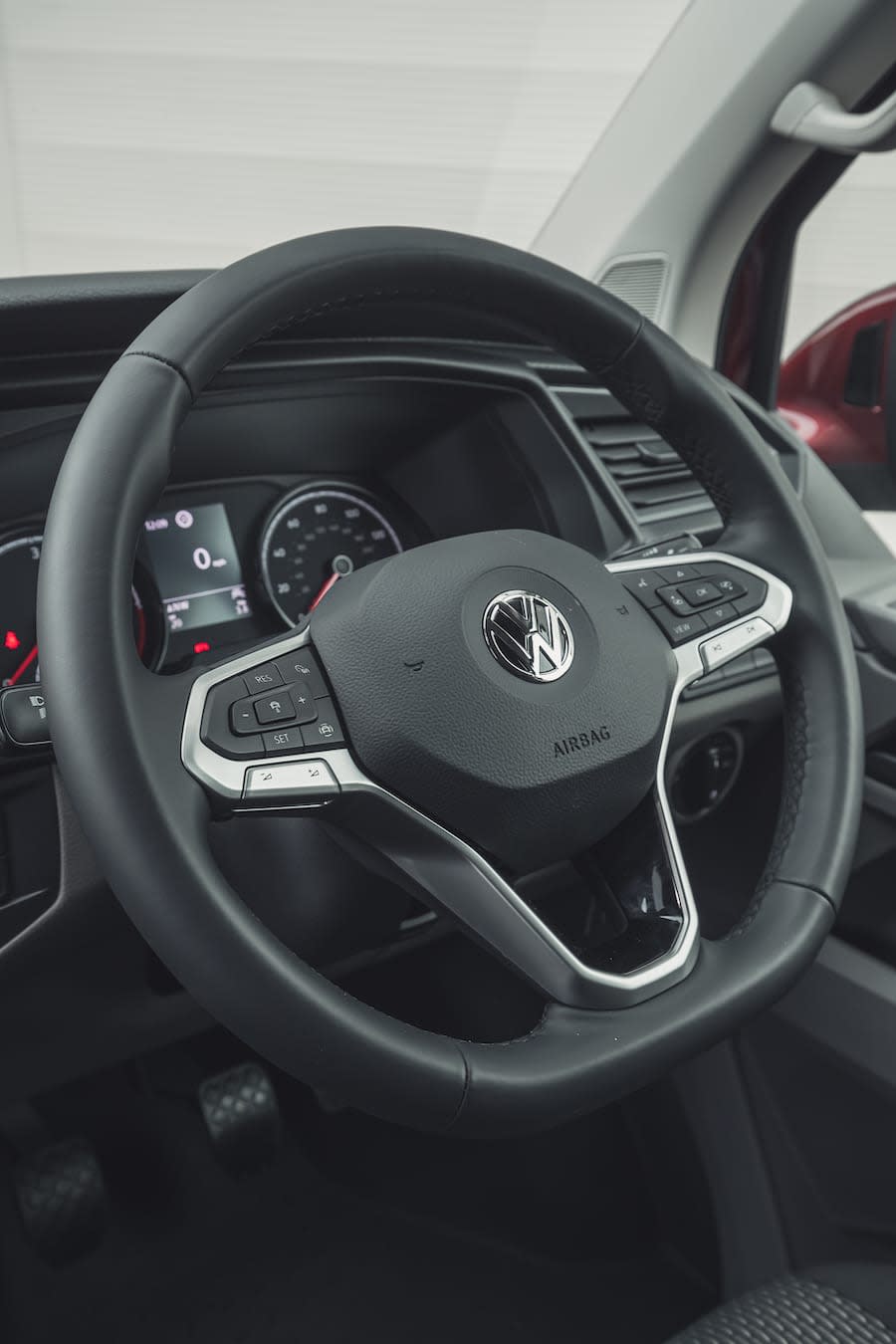
Key Features
Flexibility is the Transporters key strength. Apart from its panel van base, there’s the Kombi crew cab that allows six to sit inside the van. An eight-seater passenger version makes for a cost-effective MPV, while a nine-seater model makes a better minibus. It’s available as a camper, called California, that blends style and luxury into the mix, and a chassis cab allows for tipper conversions and suchlike.
There are few vehicles with such historic lineage and breadth of abilities.
Performance & Drive
To show off the van to its best, Volkswagen provided a Transporter with the most powerful engine, four-wheel drive and a seven-speed automatic gearbox. However, whichever Transport you choose, you’ll have a 2.0-litre diesel engine under the bonnet (with the exception, of course, of the all-electric e-Transporter.
Available in power outputs from 90hp through to the 204hp tested here, there’s a broad spectrum to shoes from. More importantly, perhaps, are the torque figures. This is what gets the van moving, and is essential in city or urban driving. Even the entry-level 90hp model puts out a handy 220Nm of torque, although that’s dwarfed by the 450Nm available in our test van.
Dashing from standstill to 62mph takes just 8.9 seconds, but that can extend as far as 17.5 seconds on lower models, although all get off the line rapidly enough; it’s at higher speeds that you’ll notice you’re in a lower power model. Jumping up from the 90hp model to the 110hp model will be a worthwhile investment if you ever venture out of the city centre.
Those two models are fitted with a five-speed manual gearbox, but the 150hp gains an extra gear. It’s also available with the seven-speed automatic gearbox as an option, which is standard on the top 204hp model. The 150hp offers a wonderful balance of performance and economy, while that extra gear means lower noise levels when cruising.
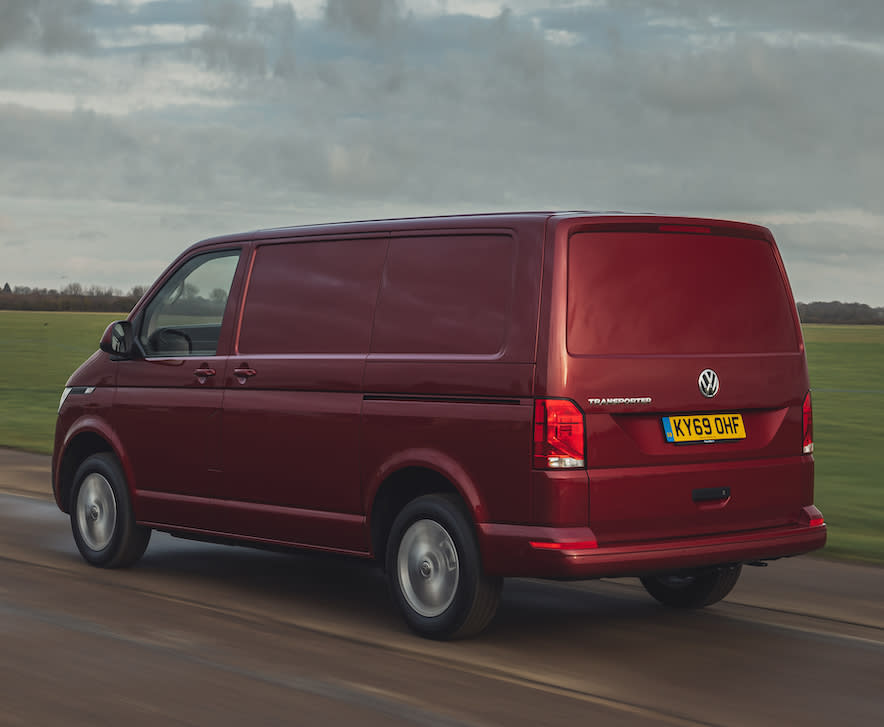
Is 204hp necessary in a medium-sized van? Probably not, but it's fun to have. Many users will be dual purpose, switching between work use during the week and leisure use at the weekend, where the extra performance might come in handy.
Electrically assisted power steering is sharp and precise, and uncannily effortless at lower speeds. Manoeuvring around town is a breeze, with a single finger being enough to twirl the wheel when reversing into a parking bay. Speed up and the steering gains resistance, promoting stability.
The suspension does a fine job of masking the worst of Britain’s roads and offers a smoother ride than the Ford Transit Custom. With a couple of hundred kilos of load in the back, it’s a more compliant ride but never gets uncomfortable even when empty. Speed bumps can cause the rear to get a little wayward, however.
The 4Motion four-wheel drive system on our test vehicle is entirely unnoticeable during everyday use and, in the bone-dry East Anglian summer, there’s not been much adverse weather to test it in. Other 4Motion models in the Volkswagen range are eminently capable, however, and there’s no reason to suspect that the Transporter won’t get through a damp field with aplomb. However, with road-biased tyres and no great ground clearance, it’s best suited to a slightly slippy building site than being used as a proper off-road van. Unless you need the extra security offered by the 4Motion system, the regular front-wheel-drive van will be cheaper and more economical.
It is, however, a rather noisy van. There tends to be a lot of engine, road and wind noise bouncing around the cabin of a Transporter, although the optional plush soft rubber flooring in the back of this model takes the edge off.
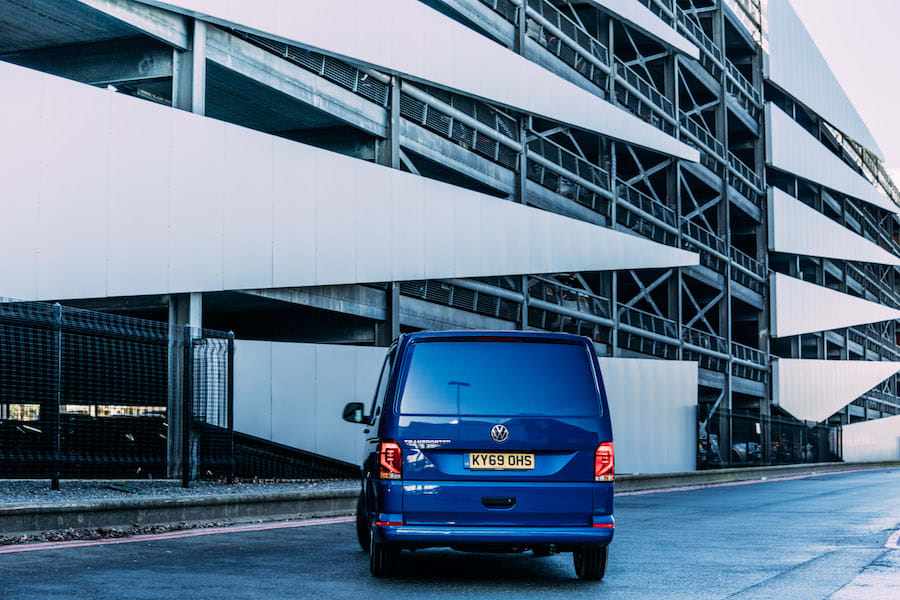
Running Costs
Look at the list prices and the Volkswagen Transport can look expensive. However, the devil is in the detail, and the German van makes up for that with competitive running costs and low depreciation.
The net result is that over, say, three years and 60,000 miles, you will probably find that the Transporter is amongst the cheapest to operate. Volkswagen is working to make it even cheaper, introducing interest-free finance on unexpected repairs and service bills.
As every Transporter uses the same engine, albeit in a different state of tune, the fuel economy is broadly similar across the range. Officially, you’ll be able to achieve as much as 40.4mpg on average, if you choose a Startline model, even if picking the 150hp model. The four-wheel-drive 204hp high-spec model tested here is rather more thirsty, promising just 34.0mpg. However, despite it being the least economical model in the range, our daily use has seen the trip computer record 35.1mpg, so there’s hope!
You will also need to ensure that the AdBlue tank is kept topped up. It’s got a 13-litre capacity, which should last around 4-5,000 miles, but if you ignore the countless, very obvious warnings to refill it you’ll find the engine won’t start and you'll need recovering.
Longer-term, the Transporter is covered by a three-year, 100,000-mile warranty. That’s not as long as some rivals but should see most through a lease plan.
Service intervals vary. You can opt for a service every 12 months or 10,000 miles, or you can pick the variable schedule. This can extend services to two years or 18,000 miles but is dependent on your driving style. Long motorway cruises under little load will see the longest time between visits to the dealer.
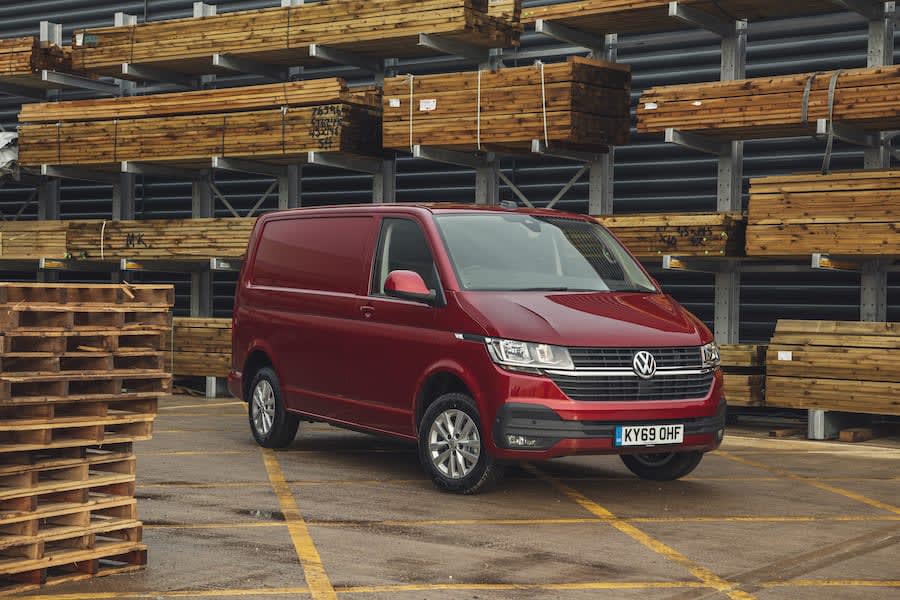
Interior and Technology
You would expect the Transporter’s cabin to be efficient, and it is. There’s a neatness and order to the dashboard that is particularly appealing, with a logical, centralised layout that makes you wonder why others can’t do the same.
The standard 6.5-inch infotainment screen looks a little small in the middle of the dash, but it’s effective and works well. The larger 8.0-inch version, with its glossy screen, looks as fresh as the latest iPhone. Both have Apple CarPlay and Android Auto, but the latter makes it wireless.
It doesn’t boot up too quickly though, which means you might already be driving before the navigation system has loaded.
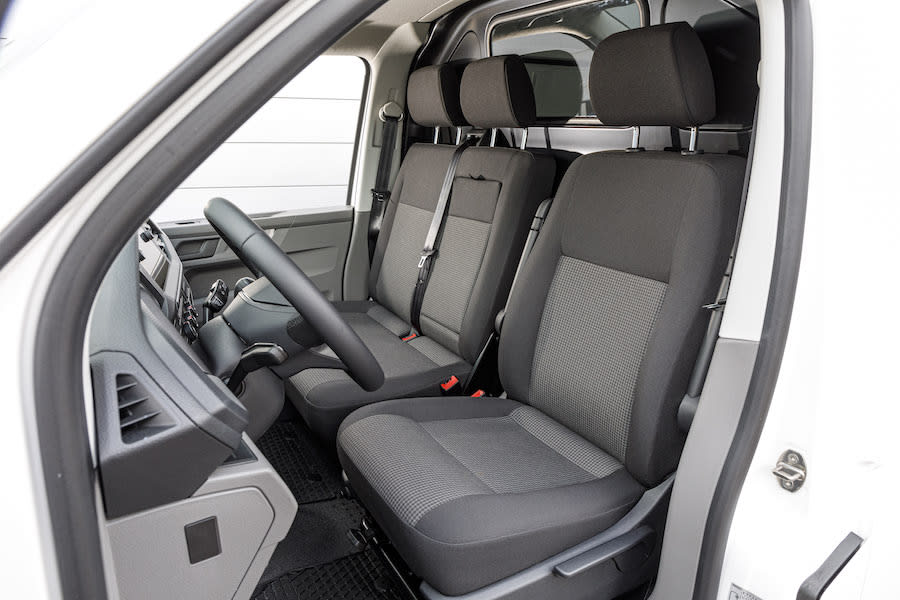
The driving position is spot on, although the seat belt isn’t height adjustable so tall or short users might find it irritating. The driver’s seat has an armrest, and there’s a cupholder above the instrument panel, so you can relax as you make your way up the M40.
The passenger side comes with a two-person bench seat. Those nearest the door will feel comfortable, with plenty of legroom and a wide frame for the window to rest an arm on. The centre passenger might feel a little hard done by in comparison, with little room and the dash-mounted gear lever stealing valuable knee room.
In standard trim, it’s a rather vocal van. There tends to be a lot of engine, road and wind noise bouncing around the cabin of a Transporter, although the optional plush soft rubber flooring in the back of this model takes the edge off, as does the Highline’s extra soundproofing.
One odd quirk is that there’s a rear-view mirror despite the van having no rear window and a solid bulkhead between the cabin and the cargo area.
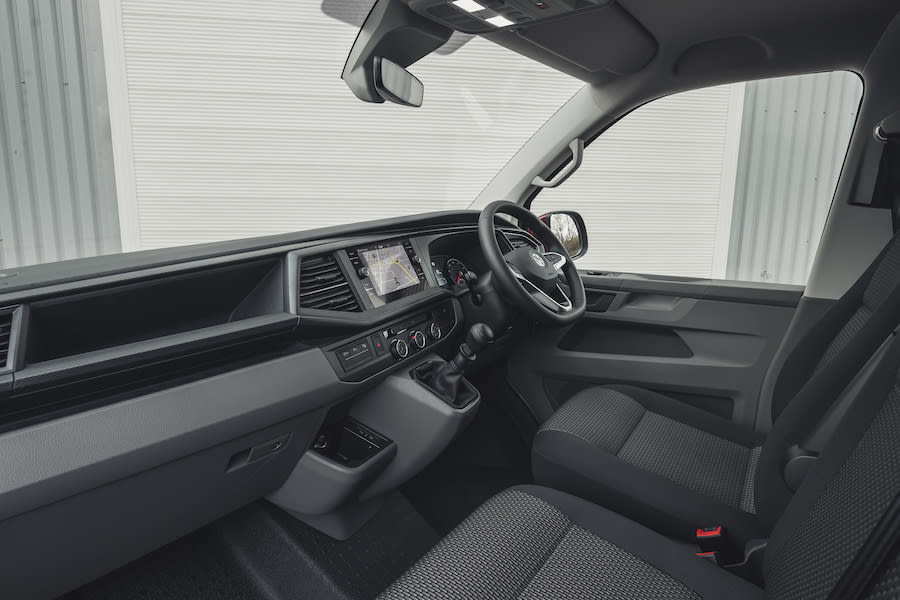
Payload and Practicality
Load up the short wheelbase Transporter we have on test and you can squeeze 1,040kg of cargo in the back. Sacrifice the 4Motion all-wheel-drive system and that adds an extra 110kg, taking it to 1,165kg. The 150hp model takes that further, to 1,218kg. At the other extreme, the 90hp model, with a gross vehicle weight of 2.3 tonnes, will only take 688kg loaded in the back.
The short wheelbase models have a load volume of 5.8m3, with the long-wheelbase models able to squeeze in an extra 0.9m3 thanks to the 40cm increase in length, taking it to 6.7m3. The longer four-wheel-drive models are also available with a high roof, rising from a 141cm tall load compartment to one that’s 194cm high. This takes the total cargo volume to 9.3m3. However, bear in mind that the long-wheelbase models remove around 60kg from the payload limit, thanks to the extra metalwork involved.
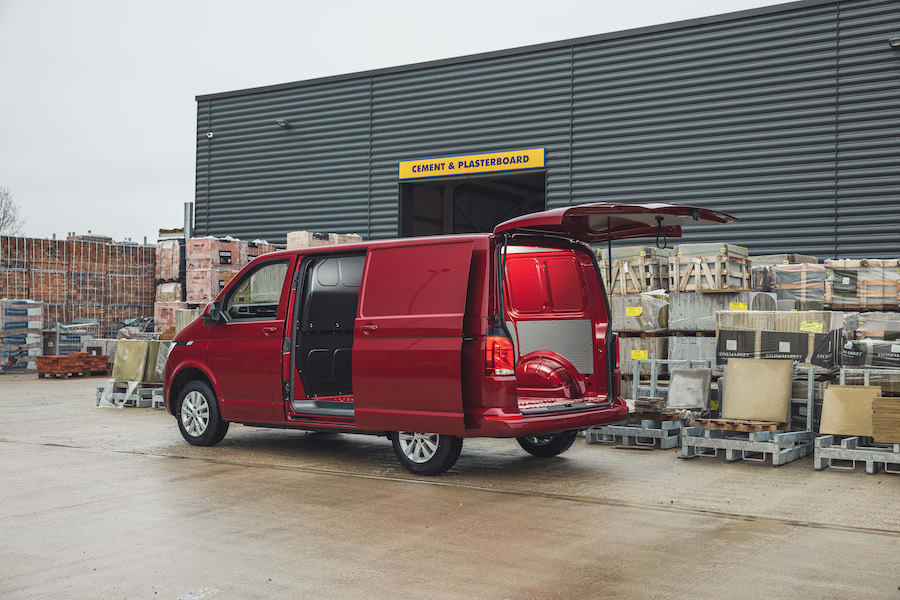
Access to the load bay is by an upward swinging tailgate, with or without a window, and a sliding door on the passenger side. Both access points are big enough to slide a Euro pallet through, with the rear door leaving an opening 1,473mm wide. More common side-hinged doors are available for £228, which may be handy for some. Whatever door option you pick, you can get two Euro pallets into the short wheelbase model thanks to its 2,572mm long compartment, and a third on the 2,975mm long-wheelbase version.
While the load compartment is competitive, there’s less positive news in the cabin. There’s not a huge amount of storage in there, and nothing with a cover on it beyond the glovebox, so any valuables will need to be small to be kept out of sight, or removed every time. Trays on the top of the dashboard are handy for paperwork but, again, with no cover, they’re going to leave documents visible and, more importantly, reflecting on the windscreen while driving.
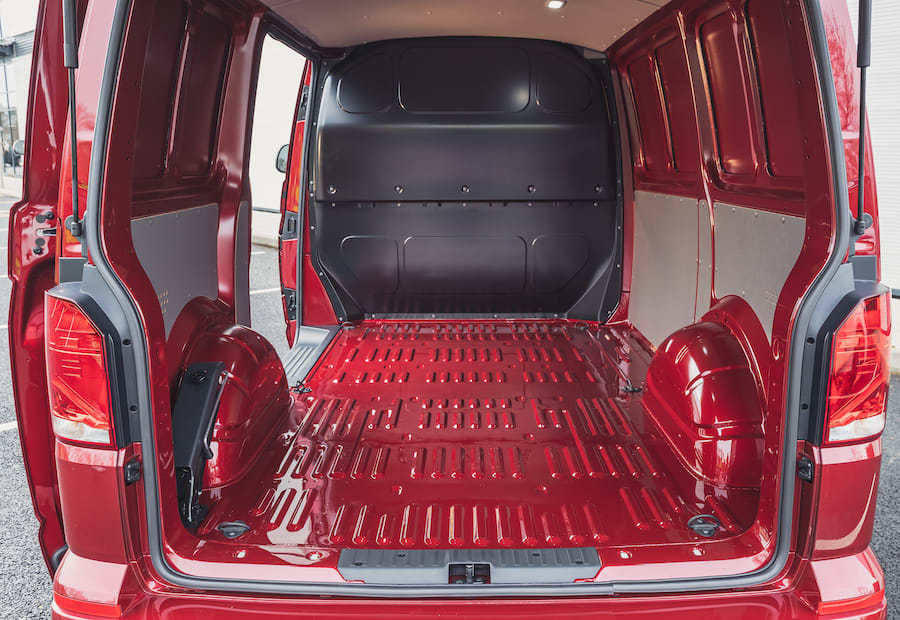
Safety
Volkswagen has comprehensively equipped the Transporter panel van with safety kit, keeping you safer and your van on the road for longer. Every model gets automatic emergency braking that helps to prevent contact with vehicles, pedestrians and cyclists, with post-collision braking support to prevent secondary impacts should your day have turned out very bad.
You’ll also find crosswind assist to keep your van on a straight path when, for example, crossing an exposed bridge. There’s also cruise control, a driver alert system that monitors for fatigue, and the usual anti-lock brakes and stability control system to help out when necessary.
The Highline model adds adaptive cruise control and parking sensors front and rear. A rear camera is a £300 option, while a semi-automatic parking system, and even trailer assist that does the same when hooked up, can be specified.
A side protection system uses an array of sensors to monitor for objects hidden to your side, helping to prevent minor accidents and keep your van on the road and insurance costs down. LED headlights will be useful for nighttime drivers but, at £1,206 and upwards, they’re not cheap.
Euro NCAP now rates vans for their safety, basing it on the equipment installed and how effective it is. It stops short of crash testing each model, but the Transporter is one of just three models to receive the top Gold rating.
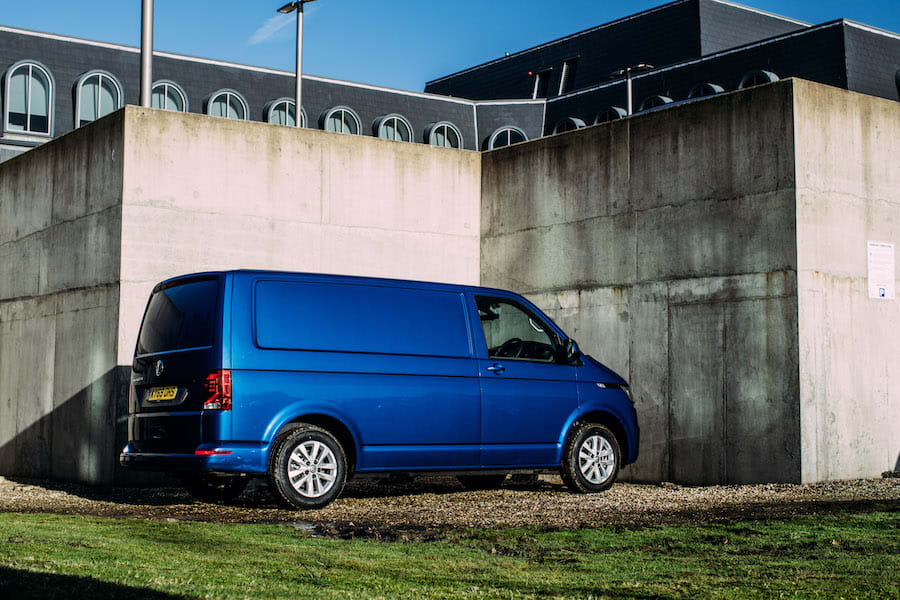
Options
There are just two trim options on the standard panel van; Startline and Highline. Splash out and you'll gain alloy wheels, air conditioning, adaptive cruise control and parking sensors front and rear, amongst other items. These alone might just be enough to justify the difference.
The Sportline model stands alone and adds spoilers, side skirts, air dams, flash alloy wheels and some red stripes. Think of it as the Transporter GTI.
Of course, the van is just the starting point. Pick up a brochure for the Volkswagen Transporter and you’ll find nine pages of options.
Adding navigation will cost an extra £1,356, but that does expand the 6.5-inch touchscreen to a more impressive eight inches, and adds wireless Android Auto and Apple CarPlay.
Those opting for a Startline model might also want to add the £306 Comfort pack. This includes an extra 12-volt socket, some grab handles, and increased sound deadening and noise suppression measures. You’ll thank us for that.
Rival Vans
Fellow German brand Mercedes-Benz produces the Vito, a van with more road presence, excellent comfort and great value, but it’s a little tight for space in the cabin and isn’t as capacious as some others.
The Ford Transit Custom is the nation’s go-to van for good reason, with a great cabin and driving dynamics, but it can be quite rough when unloaded.
The Citroen/Peugeot/Toyota/Vauxhall quartet of vans are all but identical to each other, and offer some body lengths others miss out on along with frugal motors, but with a drab cabin that slacks storage.
Verdict
There’s a lot to like about the Volkswagen Transporter, not least its everyman image that, much like the Golf hatchback, offers a classless style that will be equally at home on a building site or a private beach.
Leasing costs aren’t as high as the list prices might suggest, as it holds its value well and that makes for a lower monthly fee. Total life costs should be competitive too, and certainly less than a comparable Ford Transit Custom.
The ever-present Transit Custom is, arguably, a better option in some areas, but only just, and probably no by enough to justify the extra expense.
Given that the Transporter does most things to a high standard, it’s rather easy to recommend.
Where to next?
View latest Volkswagen Transporter Van leasing deals - guide price from £121.74 per month ex VAT**
Looking for a great leasing deal? Check out our incredible range of Special Offers
New medium van? Read our latest Van Reviews and find the right model for you
Want to know more about leasing? Take a look at our comprehensive Van Leasing Guides
Interested in everything motoring? Why not catch up on all the latest Van Leasing News.
*Score based on Select’s unique meta score analysis, taking into account the UK’s top five leading independent car website reviews of the Volkswagen Transporter Van
**Correct as of 06/12/2021. Based on 9 months initial payment, 10,000 miles over a 24 month lease. Initial payment equivalent to 9 monthly payments or £1871.91 - Ts and Cs apply. Credit is subject to status.
.jpg)















